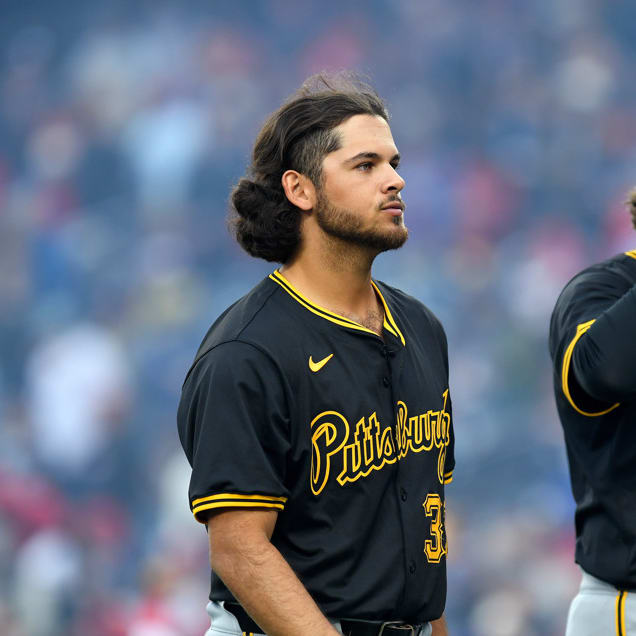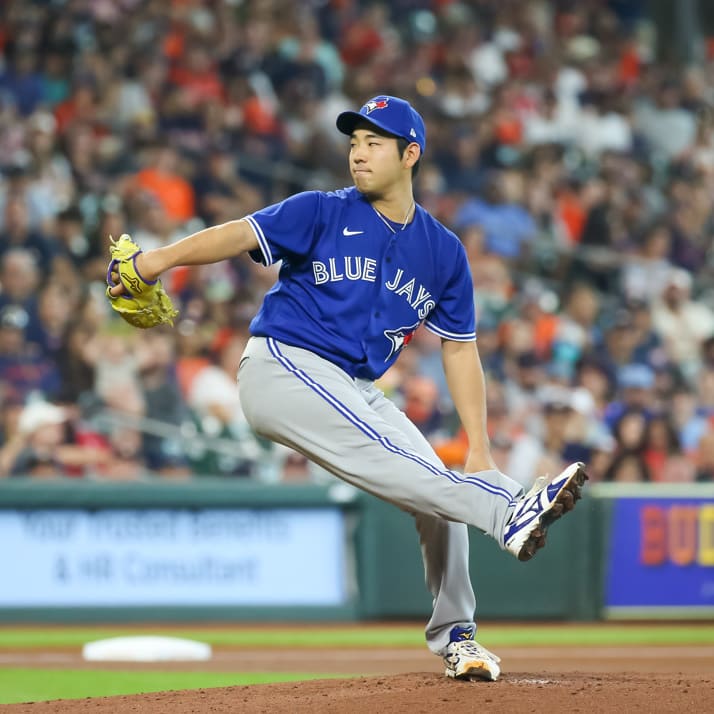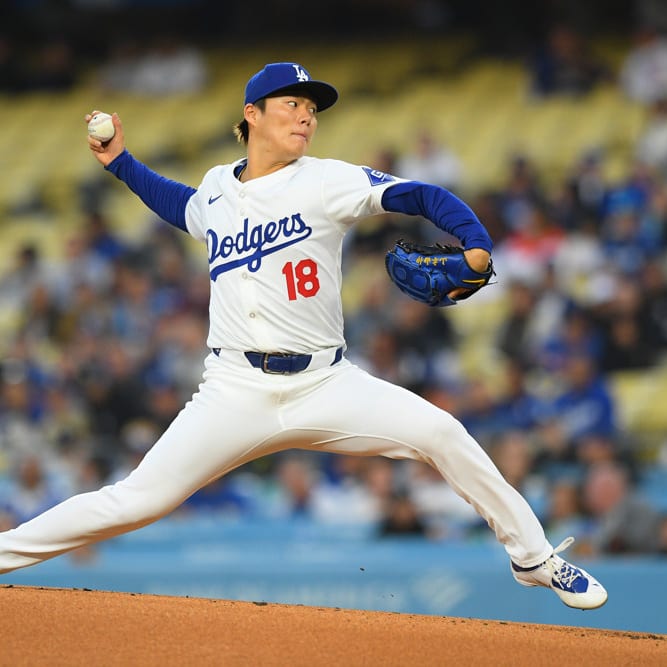This article is part of our Bogfella's Notebook series.
This Week's Scouting Tip: Which Pitcher Deserves to be First Off the Board?
Anchoring your pitching staff is generally a very good idea on draft day. There will be lots of questions and second-guessing - What round? What to target specifically about the one pitcher that will become your ace? And, of course, which pitcher deserves to be the first off the board? If I am going all in for a dominator, I want to make sure I have the very best squarely in my sights. So here's the good part. I love controversy when it comes to evaluating players from a fantasy perspective. Therefore, I will take the opportunity to start a "lively" discussion by making statements like, "this guy is the best pitcher in the game." It doesn't make any difference which name I plug in, there will be others who are adamantly opposed to my choice, and equally convinced their guy should wear the ultimate No. 1 mantle. That's the best part of this game. If we all agreed on the overall rankings, draft day would be a dreadful bore. So, why don't we consider some options when it's time to take that first pitcher next spring. There are quite a few things to include in the equation, but we will try to sort it out. Let's take a look …
Exploring it further: What Makes a Specific Pitcher The One
There are a lot of reasons to rank one pitcher over another going into the season.
This Week's Scouting Tip: Which Pitcher Deserves to be First Off the Board?
Anchoring your pitching staff is generally a very good idea on draft day. There will be lots of questions and second-guessing - What round? What to target specifically about the one pitcher that will become your ace? And, of course, which pitcher deserves to be the first off the board? If I am going all in for a dominator, I want to make sure I have the very best squarely in my sights. So here's the good part. I love controversy when it comes to evaluating players from a fantasy perspective. Therefore, I will take the opportunity to start a "lively" discussion by making statements like, "this guy is the best pitcher in the game." It doesn't make any difference which name I plug in, there will be others who are adamantly opposed to my choice, and equally convinced their guy should wear the ultimate No. 1 mantle. That's the best part of this game. If we all agreed on the overall rankings, draft day would be a dreadful bore. So, why don't we consider some options when it's time to take that first pitcher next spring. There are quite a few things to include in the equation, but we will try to sort it out. Let's take a look …
Exploring it further: What Makes a Specific Pitcher The One
There are a lot of reasons to rank one pitcher over another going into the season. Certainly, first on that list would be past performance, especially performance the previous year, but if possible you would prefer to look at two or three seasons. For more established pitchers that gives you a mean ranking - something like a best-case / worst-case scenario with the likelihood that his actual statistics will fall somewhere in the middle. For younger guys, you are probably looking for a positive trend or some signs that a breakout year could be on the horizon. Finally, for the very young, there has to be something extraordinarily special about the pitcher you are considering because without a major reason to jump, most newcomers will not justify a top-tier pick, and certainly will not be the first pitcher off the board.
With that said, we can now dig into the parameters that are most predictive of a pitcher being the kind of guy you want at the top of your fantasy rotation. Before we start, let's set aside the talk of injury risk and erratic performance. Injuries do happen - just ask this year's Adam Wainwright owners - and in many cases they are fairly unpredictable. A veteran who spends many of his summer days on the disabled list, particularly if the injuries are elbow or shoulder related, probably shouldn't be in our consideration set. Similarly, you won't find the Ricky Nolasco's of the world on our list - we want someone with better than a 50/50 chance of pitching a respectable game each and every time he steps on the mound, regardless of how good he can look on those rare days when he does actually toss a game he can be proud of. Those guys can make a case for a spot in your rotation, but not at the top of it.
First on my list of requisite traits would be innings. There are three distinct reasons this is vitally important. Pitching a lot of innings - we'll set the bar at around 200 innings with a few more being a bonus - means the pitcher is usually around long enough to pick up wins even when his team's offense doesn't kick in until the seventh or eighth inning and he has managed to minimize the number of baserunners while keeping his pitch count in line (see item No. 2 on this requisite list) and it gives the pitcher more opportunities for strikeouts (see item No. 3). Further, pitching deeper into games reduces exposure to the usually less than reliable middle relievers employed by most teams.
Secondly, as implied to above, we want our guy to have an exemplary WHIP. I usually set my over/under at about 1.200 for an average size league. It could be a bit higher in extremely deep leagues, and obviously, the lower the better. If a pitcher can get into the sub-1.000 area, he is likely to easily pitch the 200+ innings (barring injury), and he will frequently get the game into the seventh or eighth inning where the team's finest relievers - a setup man and closer are the only ones likely to see the mound. There are so many pluses to a low WHIP that it would be difficult to list them all, but the most important would include fewer baserunners when your pitcher serves up the occasional mistake, less stressful innings/pitches (often pitching in crisis situations is extremely taxing on a pitcher so tossing 120 "relaxed" pitches is probably less harmful that 80-90 with every one of them amounting to a win or lose scenario), and something as simple as the hitters seeing your stuff a minimal number of times each game.
And for the third requisite, we will add in something that makes the first and second requirements all the more difficult to accomplish - a strikeout rate that approaches or exceeds 9.00 per nine innings. Strikeout benefits are obvious. They are frequently a scoring category, they can diffuse the most tenuous situations with no damage, and as someone famous once said, they are sexy; the chicks dig 'em. I'm not saying your wife or girlfriend will pay more attention to your fantasy team if it's loaded with strikeout pitchers, but she will probably be happier just because you are usually in a better mood. So what about the downside? Well, as it relates to innings pitched/pitch count/WHIP, strikeouts are rather costly. Pitching to contact can get you a 3-5 pitch inning. Striking out the side requires nine, and usually more. Generating swings and misses requires pitching out of the strike zone at times so the pitcher is at higher risk for issuing walks (bad for the WHIP). You get the idea. We want our cake (innings and WHIP) and we want to eat it too (strikeouts to stop a potential rally in its tracks).
So when you add that all up, we want someone we can reasonably expect to pitch 200+ innings with a WHIP around 1.00 while recording 200+ strikeouts. No problem, there must be a bunch of those guys hanging around, right? Actually, you can usually count them on one hand. So how important is it that you get one of these studs? When you consider the impact of a pitcher tossing over 200 innings with those peripherals, and how much he can help you overcome those cave-ins that come with the average back of the rotation arm, it can be very important. If you don't have a genuine "ace" you almost have to have a very solid group of starters that won't make it necessary to have a stopper that can take the sting out of a few horrible starts.
There are a few other criteria to look at, including a pitcher-friendly home park, the potential for good run support, a lot of starts against weaker hitting lineups, a solid defense, extremely high quality endgame relievers, a talented pitching coach capable of quickly helping to correct the mechanical flaws that often show up at some point in the season, and the ability to consistently pitch well even when the best stuff isn't there. These are all helpful, and I guess you could consider them tie-breakers in a sense. However, they will typically not overcome shortcomings in the big three. If a pitcher has the three primary criteria - innings, WHIP, and strikeouts - and he also gets a plus in a couple of these categories, that's a bonus. On the other hand, negatives in a few of these can potentially move a guy down on our list.
We have our parameters for evaluation. The 2011 season ended today. Tomorrow is your spring draft for 2012. You want the top pitcher. Here are 12 arms in a ranked order with which to build your draft cheat sheet.
Here they are...the most likely "aces" for 2012:
1. Justin Verlander (DET) - He gives you 200+ innings and 200+ strikeouts every year with an excellent WHIP. Add in a decent hitting lineup with a reasonably friendly home park to go with a free and easy motion that significantly reduces stress and you have the formula for an ideal top of the rotation starter. It's very hard to beat excellent numbers and consistency.
2. Roy Halladay (PHI) - Halladay just keeps putting up the good numbers year after year. His strikeout rate is still good and he pitches deep into games as often as anyone in the game. The Phillies give him great support and he benefits from other "ace" quality starters on the staff. He may begin a decline at some point, but he isn't showing signs of it yet.
3. Clayton Kershaw (LAD) - He very nearly grabbed the second spot on our list. He continues to improve his command which means fewer walks and more strikeouts so there is progress being made building onto an already impressive resume. Additional ceiling is a huge plus for him as he probably hasn't come close to reaching his peak performance.
4. Tim Lincecum (SF) - When he's on, he can be as dominant as any pitcher in the game. Unfortunately, his command is a bit spotty at times, and the woeful Giants offense costs him several wins a year. If that offense is bolstered, he could easily move up a notch or two, but ideally you would like to see him pitching deeper into games with fewer walks.
5. Felix Hernandez (SEA) - There are already a lot of miles on King Felix given his relatively young age. Because he plays in a very favorable park, he benefits from a few harmless flyballs that could otherwise hurt, but that same ballpark means he often suffers from little or no run support. He is still one of the best around but his stock would rise if he found himself on a contender.
6. Cliff Lee (PHI) - Lee is somewhat older than most of the guys featured here, but he still commands attention - and that is the best way to word it. Because he issues so few walks, he keeps base runners off the paths and generally pitches deep into games. He has not always been the model of consistency you like to see, however, he is solidly in the second tier of "ace" type pitchers.
7. Jered Weaver (LAA) - The Angels just locked him up for a long time, probably avoiding the frustrations they have sometimes experienced when trying to sign high profile free agents. He has had a couple of outstanding seasons but his strikeout rate is down somewhat so he is still a notch below the top selections of draft day.
8. Cole Hamels (PHI) - It's pretty hard to get overlooked with his stuff, but Hamels pitches in the shadow of Halladay and Lee so he doesn't always get the acclaim his performance should generate. Personally, I think he has as much upside as either of his more celebrated counterparts which could increase his base value. Durability could also be a minor concern.
9. CC Sabathia (NYY) - His WHIP is a bit on the high side compared to most of the others listed here, but he is the definition of a workhorse who gives you innings and a respectable number of strikeouts to go along with frequent opportunities to garner wins pitching in front of the potent Yankees offense. It might be prudent to fill in with better ERA pitchers if Sabathia is your No. 1.
10. Ricky Romero (TOR) - This is a name that some might find surprising. Like many lefties, he has developed a bit later, but his trends suggest there is still more to come. He doesn't get the huge strikeout totals yet, but he is becoming more and more adept at getting deeper into games. Because he isn't as well known, he might be someone you could sneak into the top spot in your rotation.
11. David Price (TB) - Another lefty who is still on the way up. There is no question he can still get better and he's already pretty good. I really don't see him in the Verlander, Halladay, Kershaw or Lincecum category, however, he could progress to a position very close to theirs. His pitch counts can be a bit high at times, which slightly limits his innings, but they will likely improve as he matures.
12. Jon Lester (BOS) - Too many walks on too many pitches is what keeps him from a higher ranking. He certainly benefits from the Red Sox's offensive support but he doesn't always get the ball to the late innings specialists in the bullpen. His WHIP is high for our parameters, but it is offset by other positives and he still warrants a spot in this group.
There they are. Satisfied? I didn't think so. It would be nearly impossible to compile a ranking of the top-12 pitchers without leaving at least one or two of your favorites off the list. An honorable mention group would probably have to start with Stephen Strasburg (a very rare talent but probably looking at limited innings coming off Tommy John surgery). James Shields (a huge year in 2011 but he has to prove he can do it again and again), Tommy Hanson (injuries make him pretty risky), Dan Haren (great WHIP but not the strikeouts you want), Josh Beckett (various injuries including back problems are a danger sign), Brandon Morrow (the strikeout rate is a huge plus, but he is still a bit too inconsistent), Ian Kennedy (also lacks those big strikeout numbers), and Zack Greinke (loses points for lack of ability to consistently pitch out of jams).
Next week, I will feature a favorite exercise of mine from all my years of writing about pitchers and fantasy baseball. I will focus on your questions about specific pitchers! In the comments section, you will be able to throw out a pitcher's name, and I will give you my take on his value/future for next season. It's a lot of fun, so be thinking of a guy you want to know about.
For some of the most in-depth coverage of all things pitching in fantasy baseball for 2011, visit www.bogfella.com and be sure to follow @RotoWire and @bogfella on Twitter.










